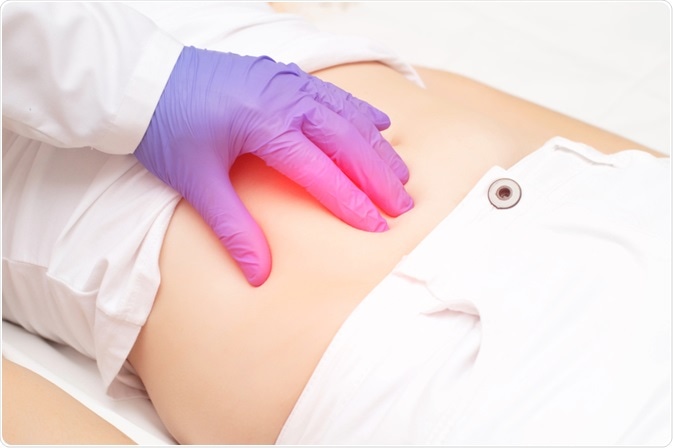The organs of the abdominal cavity (stomach, intestine, pancreas, liver, kidney, gallbladder, etc.) are surrounded and supported [held in place] by a 2-layer membrane called the peritoneum.
The peritoneum surrounds and supports the organs and protects the abdominal cavity from infectious agents. The outer layer of peritoneum adheres to the abdominal wall while the inner layer sits directly on the organs. A small amount of peritoneal fluid exists between the two layers, called the peritoneal cavity.

Image Credit: HENADZI KlLENT / Shutterstock
Peritonitis is inflammation of the peritoneum, typically due to infection by bacteria or fungi. The infection can appear as acute or chronic and can be classified as local (contained to one area of the peritoneal cavity) or diffuse (spread throughout peritoneal cavity). Peritonitis results in abdominal pain and tenderness, nausea, vomiting, bloating or a feeling of fullness, fever, diarrhea, and fatigue and requires immediate medical attention. Untreated peritonitis can result in sepsis, a full-body infection and immune response that leads to a severe drop in blood pressure, shock, damage to internal organs, and sometimes death.
Peritonitis can be classified as a spontaneous, secondary, or tertiary infection, depending on its root cause.
Spontaneous Peritonitis
Spontaneous peritonitis is an acute bacterial infection of the peritoneal fluid. It is commonly found in patients experiencing ascites, which is a buildup of excessive fluid in the peritoneal cavity. [Upon examination, the peritoneal fluid may appear cloudy and can be cultured to determine the infectious agent.] Spontaneous peritonitis is found in patients with cirrhosis of the liver due to excessive alcohol consumption or infection with the hepatitis virus B or C. More commonly, however, spontaneous peritonitis is found in patients receiving peritoneal dialysis (PD)—a method of filtering toxins and other waste products from the blood in people with kidney failure. Peritonitis is a leading complication of PD and a significant factor in PD-related deaths. PD patients who develop peritonitis may experience redness, tenderness, and swelling around the catheter site or observe cloudy dialysis filtrate. The International Society for Peritoneal Dialysis has created guidelines for the management, treatment, and prevention of peritonitis in PD patients. Importantly, increased patient and caregiver hygiene can significantly reduce the risk of infection. Treatment for spontaneous peritonitis is typically antibiotics.
Secondary and Tertiary Peritonitis
Secondary peritonitis is inflammation that occurs as a consequence of another medical condition. Most often, this is due to perforation of the gastrointestinal tract that releases bacteria into the peritoneal cavity, which can occur as result of a peptic ulcer, ruptured appendix, or traumatic injury such as from a gunshot or knife wound. Secondary peritonitis can also be caused by pancreatitis (infection of the pancreas) that releases inflammatory contents into the peritoneal cavity. Due to the nature of these causes, secondary peritonitis often requires surgery to remove and repair damaged tissue along with a course of antibiotics.
In rare cases, peritonitis remains even after surgical and medical treatment of secondary peritonitis. This is called tertiary peritonitis and is defined as infection that persists 48 hours after surgical and medical intervention. Tertiary peritonitis is often the result of antibiotic-resistant bacteria.
Further Reading